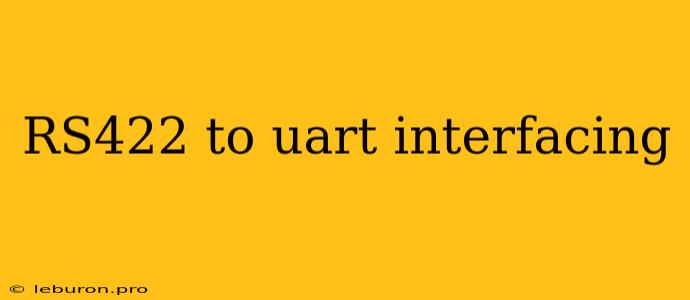RS422 to UART Interfacing: Bridging the Communication Gap
The world of data communication is vast and varied, with different protocols and standards employed for different applications. Two such standards, RS422 and UART, play crucial roles in transmitting data across various devices. While RS422 excels in long-distance, high-speed, and noise-resistant communication, UART is commonly used for short-distance, simple communication needs. The need to bridge these two standards arises often, prompting the development of solutions for RS422 to UART interfacing. This interfacing enables communication between devices using different protocols, opening up a wider range of possibilities in the field of data transfer.
Understanding RS422 and UART
Before delving into the details of RS422 to UART interfacing, it's crucial to understand the fundamental differences between these two communication protocols.
RS422: The Long-Distance Champion
RS422 (Recommended Standard 422) is a balanced, differential signaling standard designed for high-speed, long-distance data communication. Key features of RS422 include:
- Differential Signaling: Data is transmitted using two signals, one with positive voltage and the other with negative voltage. This approach effectively cancels out common-mode noise, making RS422 highly resistant to external interference.
- High Data Rates: RS422 can achieve data rates of up to 10 Mbps over distances exceeding 1000 meters.
- Multi-Drop Capability: Multiple devices can be connected to the same bus, enabling a point-to-point or multi-point communication architecture.
- Balanced Transmission: The balanced nature of RS422 further enhances noise immunity by minimizing the impact of electromagnetic interference.
UART: The Simple and Versatile Standard
UART (Universal Asynchronous Receiver/Transmitter) is a serial communication protocol widely used for short-distance data transfer between devices. Key features of UART include:
- Asynchronous Communication: UART allows devices to communicate without needing a shared clock signal. Each device operates independently, relying on start and stop bits for data synchronization.
- Simple Implementation: UART communication is relatively straightforward to implement, requiring minimal circuitry.
- Low Cost: The simplicity of UART makes it a cost-effective solution for various communication needs.
- Wide Availability: UART is widely supported in microcontrollers, embedded systems, and other devices, making it highly accessible.
Why the Need for RS422 to UART Interfacing?
The need for RS422 to UART interfacing arises from the necessity to connect devices that use different communication protocols. Here are some common scenarios where this interfacing becomes crucial:
- Connecting Legacy RS422 Devices to Modern UART Systems: Many industrial control systems and older devices still utilize RS422 for communication. Interfacing these devices with modern UART-based systems requires a bridging solution.
- Extending UART Communication Range: RS422's ability to transmit data over long distances makes it suitable for extending the range of UART communication.
- Integrating RS422 Sensors into UART Systems: Many industrial sensors use RS422 for data transmission. By converting the RS422 signals to UART, these sensors can be seamlessly integrated into UART-based data acquisition systems.
- Creating Hybrid Communication Systems: In some scenarios, a system might require both RS422 and UART communication capabilities. An RS422 to UART interface can act as a bridge, enabling communication between devices using different protocols.
Solutions for RS422 to UART Interfacing
Several solutions exist for RS422 to UART interfacing, each with its unique characteristics and advantages. Here are some prominent options:
- Dedicated RS422 to UART Converter Chips: These chips are specifically designed to perform the conversion between RS422 and UART signals. They typically offer features like selectable baud rates, data direction control, and low power consumption.
- Microcontroller-Based Solutions: Microcontrollers with built-in UART interfaces can be programmed to handle RS422 to UART conversion. This approach allows for greater flexibility and customizability, but requires additional software development.
- FPGA-Based Solutions: Field-Programmable Gate Arrays (FPGAs) provide a highly flexible platform for implementing RS422 to UART conversion. FPGAs allow for complex logic implementation and can be customized to meet specific application requirements.
- Ready-Made RS422 to UART Modules: Several ready-made modules are available, offering a convenient and cost-effective solution. These modules typically integrate all necessary circuitry for conversion and can be easily interfaced with UART-enabled devices.
Considerations for Choosing the Right Solution
Choosing the right solution for RS422 to UART interfacing depends on several factors, including:
- Application Requirements: The specific requirements of the application, such as data rate, distance, and noise immunity, play a significant role in selecting the appropriate solution.
- Cost: The budget allocated for the interfacing solution is a crucial factor. Dedicated converter chips are typically cost-effective, while FPGA-based solutions might be more expensive but offer greater flexibility.
- Development Complexity: The level of software development required can vary depending on the chosen solution. Ready-made modules offer the simplest solution, while microcontroller or FPGA-based solutions require more software development.
- Availability: The availability of components and support for the chosen solution should be considered.
Conclusion
RS422 to UART interfacing plays a vital role in enabling communication between devices using different protocols. Understanding the fundamental differences between RS422 and UART, the various solutions available, and the key considerations for choosing the right solution is essential for successfully bridging the communication gap between these two standards. By selecting the appropriate solution, developers can seamlessly integrate RS422 devices into UART-based systems, expanding the capabilities and possibilities of data communication within their projects.
